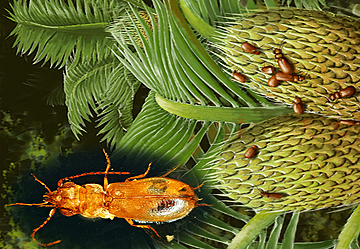Abstract
Ekaterina Alekseevna Sidorchuk (Katya to all that knew her) (Fig.1) was born in Moscow into a family of scientists: her father was a geomorphologist and her mother a Quaternary palynologist. Soil/peat microsamples from the North Russian Quaternary, the main research material of her mother, are commonly rich in oribatid mites, which Katya started to study when she entered the Geographical Faculty of Moscow State University after completing her high school education in 1998. In the Department of Biogeography, her study of Quaternary oribatids was guided by the known Russian acarologist, the late Prof. Dmitry Krivolutsky. Katya graduated from the University in 2004 and post-graduated in 2007 when she obtained her PhD degree for the study titled “Oribatid mites as bio-indicators of environmental change during the Holocene (modern and fossil bog communities of Northern European Plain)”. The next year, 2008, she entered the A.A. Borissiak Paleontological Institute and worked at the Arthropoda Laboratory until her recent untimely departure.
References
Klimov, P.V. & Sidorchuk, E.A. (2011) An enigmatic lineage of mites from Baltic amber shows a unique, possibly female-controlled mating. Biological Journal of the Linnean Society, 102 (3), 661–668.
https://doi.org/10.1111/j.1095-8312.2010.01595.x
Rasnitsyn, A.P., Bashkuev, A.S., Kopylov, D.S., Lukashevich, E.D., Ponomarenko, A.G., Popov, Y.A., Rasnitsyn, D.A., Ryzhkova, O.V., Sidorchuk, E.A., Sukatsheva, I.D. & Vorontsov, D.D. (2016) Sequence and scale of changes in the terrestrial biota during the Cretaceous (based on materials from fossil resins). Cretaceous Research, 61, 234–255.
https://doi.org/10.1016/j.cretres.2015.12.025
Sidorchuk, E.A. (2011) Preparation of six-sided micro-samples of Baltic amber for study of organismal inclusions. In: Kostyashova, Z.V. (Ed.), Amber Mining and Processing in Sambia, 12–14 May 2010. International Symposium Materials. Immanuel Kant Russian State University Publ., Kaliningrad, pp. 47–53 [in Russian].
Sidorchuk, E.A. (2013) New Technique for preparation of small-sized amber samples with application to mites. In: D. Azar, M. S. Engel, E. Jarzembowski, L. Krogmann, A. Nel, and J. Santiago-Blay (Eds), Insect Evolution in an Amberiferous and Stone Alphabet. Proceedings of the 6th International Congress, on Fossil Insects, Arthropods and Amber. Brill, Leiden-Boston, pp. 189–201.
https://doi.org/10.1163/9789004210714_014
Sidorchuk, E.A. & Klimov, P.B. (2011) Redescription of Acarus rhombeus Koch & Berendt, 1854 (Acari: Astigmata: Glaesacarus, Glaesacaridae gen. et fam. nov.) from Baltic amber (Upper Eocene): evidence for female-controlled mating. Journal of Systematic Palaeontology, 9 (2), 183–196.
https://doi.org/10.1080/14772019.2011.566585
Sidorchuk, E.A., Perrichot, V. & Lindquist, E.E. (2015) A new fossil mite from French Cretaceous amber (Acari: Heterostigmata: Nasutiacaroidea superfam. nov.), testing evolutionary concepts within the Eleutherengona (Acariformes). Journal of Systematic Palaeontology, 14, 297–317.
https://doi.org/10.1080/14772019.2015.1046512
Sidorchuk, E.A. & Vorontsov, D.D. (2014) Computer-aided drawing system—substitute for camera lucida. Acarologia, 54, (2), 229–239.
https://doi.org/10.1051/acarologia/20142130
Sidorchuk, E.A .& Vorontsov, D.D. (2018) Preparation of small-sized 3D amber samples: state of the technique. Palaeoentomology, 1 (1), 80–90.

